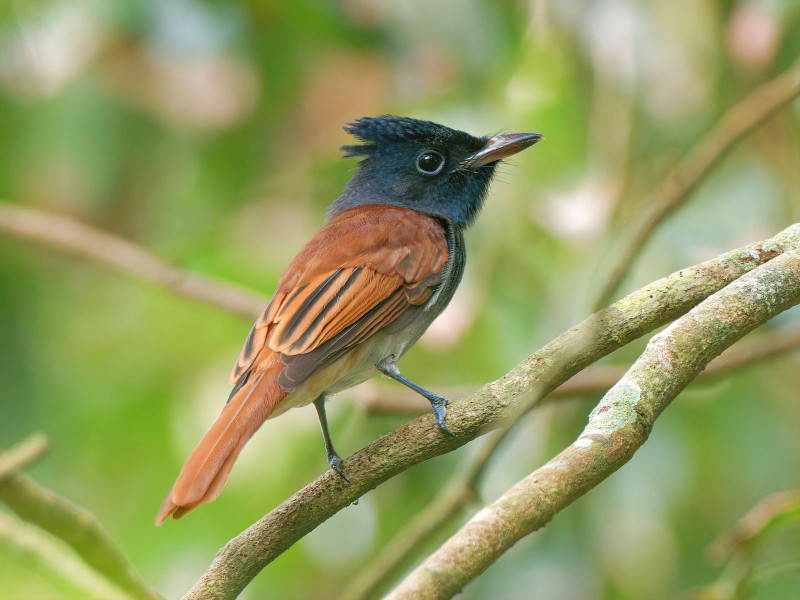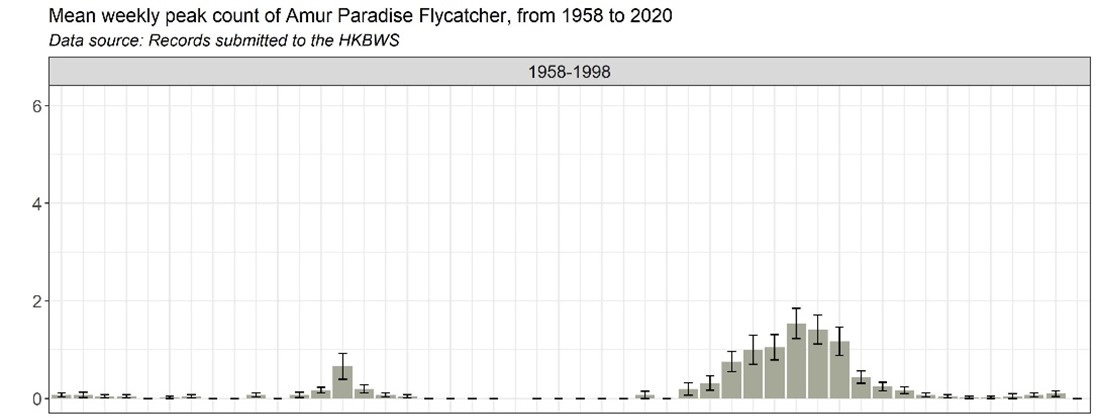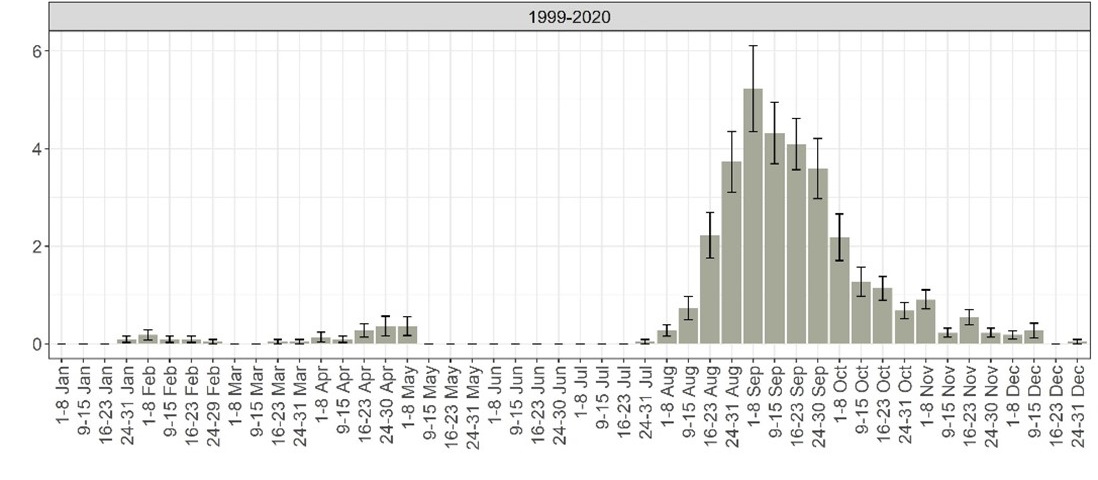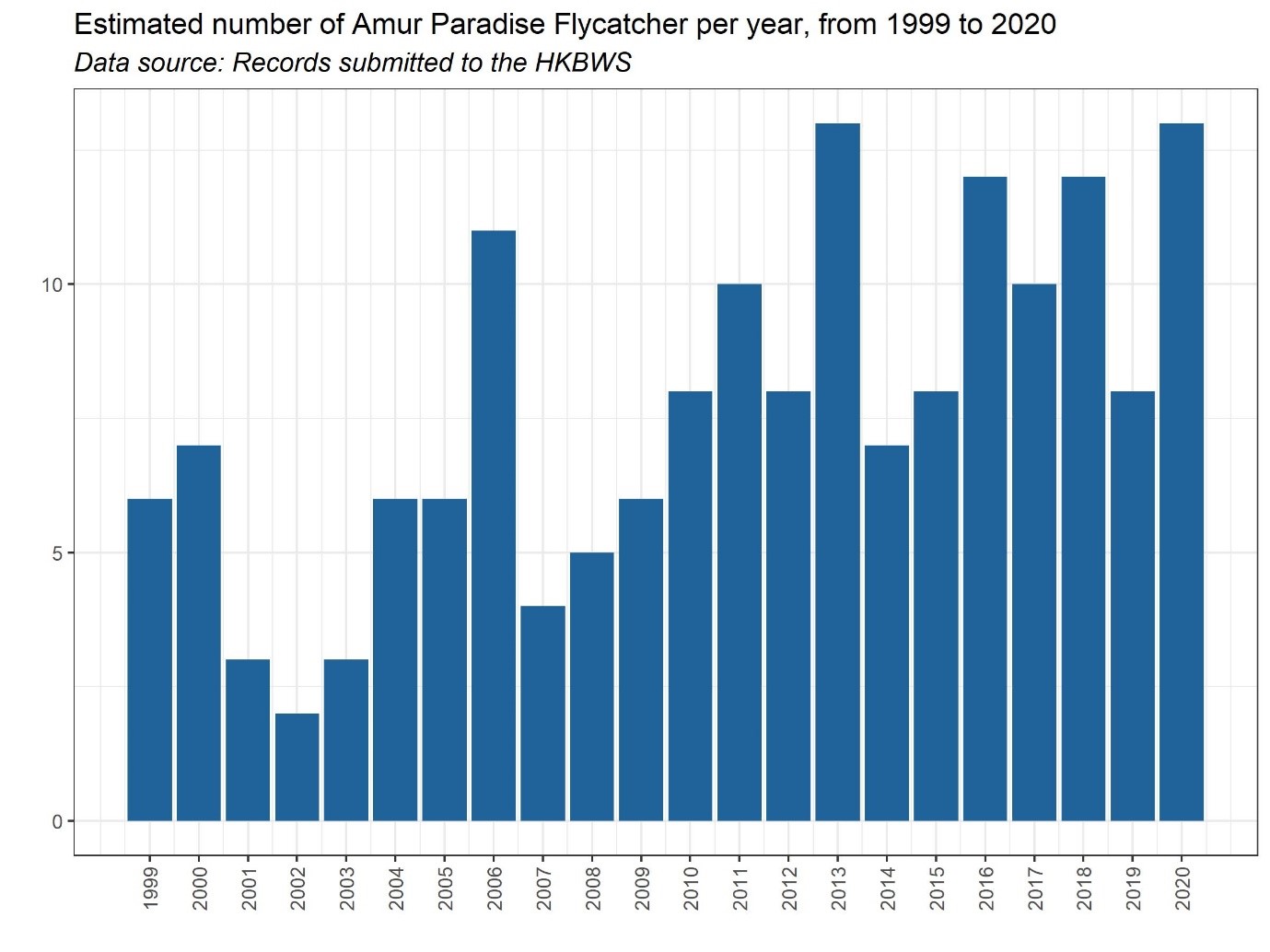Amur Paradise Flycatcher Terpsiphone incei 綬帶
Category I. Passage migrant, fairly common in autumn, scarce in spring, and rare winter visitor; prefers closed-canopy woodland.
IDENTIFICATION

Sep. 2025, Martin Williams.
20–22 cm. In all plumages has warm chestnut upperparts and tail, usually distinct border between head and throat but diffuse separation between the breast and belly. Male has glossy bluish-black head, nuchal crest and throat; in breeding plumage central tail feathers are very long, extending up to 30 cm beyond rest of the tail. Bill greyish-blue with blackish tip (sometimes pinkish-white base and tip in autumn). Also occurs in a much less common white morph. Female similar, but smaller (17·5–21 cm) with shorter tail that lacks elongated central feathers, thinner blue eye-ring, less glossy head and greyish-blue bill.

Sep. 2009, CHENG Nok Ming.
First-winter birds (illustrated) resemble adult female but are duller with less distinct eye-ring and dark brown bill usually with pale base to lower mandible. Border between head and throat can be more diffuse than on adults (possibly on males). Differs from Japanese Paradise Flycatcher in having distinct contrast between glossy head and chest but diffuse border of chest with belly, rufous-edges to primary coverts and brighter mantle showing little contrast with tail.
VOCALISATIONS
Quite vocal in autumn when its distinctive disyllabic call can be heard in forest areas.
The song is a rapidly repeated series of three note phrases.
DISTRIBUTION & HABITAT PREFERENCE
Widespread in closed-canopy wooded habitat. Many records are from mature forest on the Tai Mo Shan massif, but also regularly reported from migration sites such as Po Toi and Ho Man Tin.
OCCURRENCE
A common passage migrant, scarce to common in spring and common in autumn. Amur Paradise Flycatcher is now scarcer on spring passage than in the 1980 and 1990s, especially in the context of increased observer activity in past decade. It occurred in approximately one out of two years during 1999 -2020 but in 70% of years in the earlier period, and only 4% of all records occurred in spring in the most recent period compared with 12% during 1958-1998.
Extreme dates are 16 March and 8 May, with a peak in the last week of April and the first week of May. No more than four individuals are generally recorded on spring migration in any one year, and no more than two at any one site.
There are only two summer records. A pair that bred at Chung Hom Kok in May 1935 was the first HK record of the species (Pereira 1935), and one was at Ho Man Tin on 28 and 30 July 1978.
There has been an increase in numbers recorded in autumn in recent years though in part at least this reflects increased observer activity. The earliest date is 29 July and main passage occurs from the third week of August to the second week of October, with a peak in the first week of September. The highest single-site count is seven at Kap Lung on 9 September 2000. The end of autumn passage is ill-defined as sightings, especially in recent years, have extended into the second week of December (Figure 1). The status of birds from mid-November to early December is unclear, but they are probably best regarded as late autumn migrants rather than wintering birds.
During 1999-2020 there were no winter records between 13 December and 24 January except for one in Tai Po Kau on 26 December 2004. Late winter sightings have occurred from 24 January to 23 February in four recent years with no more than three birds in any one winter. There is no strong evidence that wintering birds remain in a single area for long, although one was at Shing Mun from 24 January to 5 February 2009.
Total annual numbers are variable with low counts of six in 2001 and 2002. However, counts since then have all been in double digits, with a general increase since 2006 (Figure 2). The estimated annual number of individuals rose to 47 in 2015, and the highest count was an unprecedented 65 in 2020. This seems to represent a real increase in numbers, exclusively in autumn, although a rise in observer activity must also play a part.
There have been three records of white-morph males. What is presumed to be the same bird was at Lam Tsuen on 15 March, 11 April and 26 October 1986, 30 January, 21 February and 4 April 1987, and 13th and 23 February 1988. In addition, singles were at Tai Po Kau on 8 October 2003 and on Po Toi on 15 September 2013.
Herklots (1941) recorded birds on passage during 6-20 April, from 14 September to 5 October and once on 17 February 1940 (Herklots 1940). It was recorded in spring and autumn by Dove and Goodhart (1955).
BREEDING
A nest containing four young was discovered in a large tree at Chung Hom Kok on 26 May 1935. It was cup-shaped and composed of rootlets, grasses and twigs. The exterior was wrapped with strips of bark, not unlike rough hemp, and was pasted with mosses and bits of decayed leaves (Pereira 1935).
BEHAVIOUR, FORAGING & DIET
Usually occurs singly, although there are occasional records of more than one bird together, particularly in bird-waves. Four in a single party at Pak Sha O on 6 September 2020 is exceptional.
Feeds on insects. Often seen in mixed foraging flocks on autumn migration. Very active. Regularly hawks flying insects from a perch.
SYSTEMATICS & RANGE
Monotypic species that breeds in Russian Far East, North Korea and China south of a line from southeast Tibet to Liaoning (Liu and Chen 2020). However, based on HK records it appears to be only a migrant along the south coast. Winters in Indochina, Thailand, Malaysia and Sumatra (del Hoyo et al. 2020). Previously treated as subspecies of Asian Paradise Flycatcher T. paradisi incei.
CONSERVATION STATUS
IUCN: Least Concern. Population trend stable.
Figure 1.


Figure 2.

Brazil, M. (2009). Birds of East Asia. Helm, London.
del Hoyo, J., N. Collar, D. A. Christie, and G. M. Kirwan (2020). Amur Paradise-Flycatcher (Terpsiphone incei), version 1.0. In Birds of the World (J. del Hoyo, A. Elliott, J. Sargatal, D. A. Christie, and E. de Juana, Editors). Cornell Lab of Ornithology, Ithaca, NY, USA. https://doi.org/10.2173/bow.amupaf1.01
Dove, R. S., and Goodhart, H. J. (1955). Field Observations from the Colony of Hong Kong. Ibis 97: 311-340.
Herklots, G. A. C. (1940). Notes and comments. Ornithology. Hong Kong Naturalist 10: 122-127.
Herklots, G. A. C. (1941). Notes and comments. Ornithology. Hong Kong Naturalist 10: 223-231.
Liu, Y. and Y. H. Chen (2020). The CNG Field Guide to the Birds of China (in Chinese). Hunan Science and Technology Publication House, Changsha.
Pereira, R. A. (1935). Notes and comments. Ornithology. Hong Kong Naturalist 6: 148, 150-153.

